
RIC X
Arcadius to the end of the Western Empire
(395-476 AD)
African (RIC X 3801-3819)
Catalogue:
|
Eastern Empire Leo II and Zeno (RIC X 801-808) Zeno (1st reign) (RIC X 901-904) |
Western Empire Priscus Attalus (RIC X 1401-1417) Constantine III (RIC X 1501-1546) Maximus of Barcelona (RIC X 1601-1604) Jovinus and Sebastianus (RIC X 1701-1722) Theodosius II (RIC X 1801-1811) Valentinian III (RIC X 2001-2187) |
Western Empire (con't) Julius Nepos (RIC X 3201-3254) Romulus Augustus (RIC X 3401-3422)
Non-Imperial issues Spanish (Suevi?) (RIC X 3786-3788) African (RIC X 3801-3819) |
| RIC # | Picture | Description | Mintmarks and (Rarity) |
| AR siliqua - RIC X, 3801 (Carthage) |
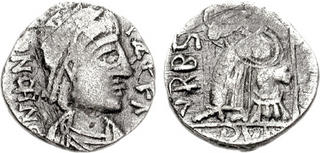 |
VANDALS. Gaiseric(?). AD 428-477. AR Siliqua (2.01 g, 12h). Carthage mint. Struck in the name of Honorius, circa AD 455-476. Pearl-diademed, draped, and cuirassed bust right / Roma seated left on cuirass, holding Victory and spear; RVPS. RIC X 3801; C. Morrisson and J. H. Schwartz, ďVandal Silver Coinage in the Name of Honorius,Ē MN 27, pp.159-160 and cf. 85-86; cf. BMC Vandals 8; MEC 1, 2. (Image courtesy CNG) | |
|
Bonifatius was a Roman general and comes Africae, a friend of
St. Augustine and the rival of Flavius AŽtius. Beginning in AD 413,
he was sent to deal with the two main Germanic tribes ravaging
Romeís western provinces Ė the Visigothic king Ataulf at Massilia in
AD 413, and the Vandals in Spain in AD 422. Because of these
successes, Bonifatius appears to have been appointed comes
Africae shortly thereafter. Upon the death of Honorius in AD
423, Joannes, the primicerius notariorum, seized power in the
west. While the remaining provinces acknowledged Joannes as emperor,
Bonifatius refused to do so, and prevented African grain shipments
from reaching Rome. When Joannes was overthrown and Valentinian III,
the son of Honoriusís sister Galla Placidia, was installed as Roman
emperor in the west by Theodosius II, Bonifatius supported him,
resuming the grain supply. AŽtiusís political intrigues against
Bonafatius, however, produced disastrous results, not only for
Bonafatius, but also for the empire. Under the influence of AŽtius, Galla Placidia became suspicious of Bonifatiusís intentions, going so far as to accuse the comes of treason. Refusing to surrender and face execution, Bonifatius sought the assistance of the Vandal king, Genseric, and offered him the right to settle in Africa in return for providing mercenaries for a possible war with the empress. Genseric agreed and the entire Vandalic people migrated across from Spain to settle in Africa. At the same time, however, Bonifatius had returned to imperial favor. No longer requiring mercenaries, he informed Genseric that the Vandals should return to Spain. Angered by this rejection, the Vandals attacked and pursued Bonafatius to the provinceís capital, Hippo Regius, in AD 430. There, they conducted a year-long siege of the city, during which time St. Augustine, bishop of the city, perished. Bonifatius, along with a large portion of the citizens were able to flee to Italy, leaving Africa under the rule of the Vandals for the next century. The arrival of Bonifatius in Italy renewed the political intrigue of AŽtius, who saw his rivalís restoration to imperial favor and promotion as a sign of his own downfall. Fearing dismissal, AŽtius and his Germanic mercenaries marched against Bonifatius, meeting him at the Battle of Rimini in AD 432. Although Bonifatius won the battle, he was mortally wounded and died a few months later. The attribution of this type to Bonifatius is not certain, but hoard evidence suggests this issue was minted at Carthage, by virtue of its connection to similar issues with legends specifically naming Carthage, and belongs to the early 5th century, almost certainly before the siege of Hippo Regius in AD 430. The obverse legend sequence, moving from DOMINO NOSTRO to DOMINIS NOSTRIS, corresponds to the position of Bonifatius during the usurpation of Joannes and his support of the legitimate Roman emperors: the first legend reflects his loyalty to Theodosius II during the usurpation of Johannes usurped the throne in Rome, while the second demonstates his allegiance to Valentinian III, as well as Theodosius II (see RIC X, pp. 233-4). |
|||
| AE4 - RIC X, - |
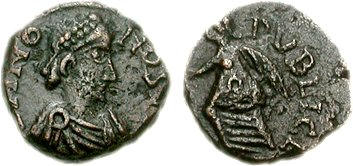 |
Bonifatius. Comes Africae, AD 422-431. ∆ 10mm (0.95 g, 6h). Carthage mint. Struck AD 423-425. DOMINO NOSTRO, pearl-diademed, draped, and cuirassed bust right / SALVS REI PVBLICE, Victory advancing left, holding wreath and palm. Cf. RIC X 3805-12 for obverse type, cf. RIC X 3813 for reverse legend. (Image courtesy CNG) | |
| AE4 - RIC X, 3810 (Carthage?) |
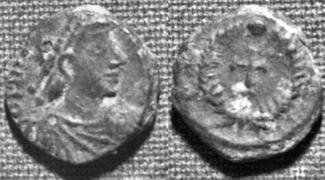 |
Bonifatius. Comes Africae, AD 422-431. ∆ 11mm (1.20 g). Carthage mint. Struck AD 423-425. DOMINO NOSTRO, pearl-diademed, draped, and cuirassed bust right / Cross within wreath. RIC X 3810. (Image courtesy ACC) | |
| AE4 - RIC X, 3814 (Carthage?) |
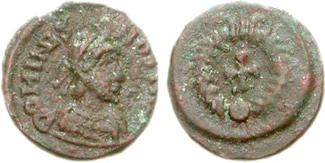 |
Bonifatius. Comes Africae, AD 422-431. ∆ 11mm (1.20 g, 12h). Carthage mint. Struck AD 423-425. DOMINIS NOSTRIS, pearl-diademed, draped, and cuirassed bust right / Cross within wreath. RIC X 3814. (Image courtesy CNG) | |
| AE4 - RIC X, 3815 (Carthage?) |
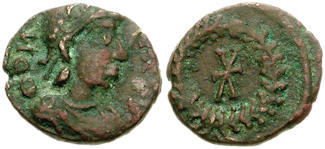 |
Non-Imperial Coinages in Africa. ďDomino NostroĒ.Circa 5th century. ∆ Nummus (11mm, 0.75 g). DOM INIS NOSTRIS, diademed and draped bust right / Crude Christogram in wreath. Cf. RIC X 3815 (star). (Image courtesy CNG) ***The Domino Nostro coinage has been attributed to Boniface of Carthage, who held north Africa during the usurpation of Johannes (423-425), but solid evidence is lacking. RIC describes the reverse of this type as a ďstarĒ, without illustration, but the elongated central shaft clearly represents a crude Christogram. The Christogram does appear occasionally as a main coin type on gold as early as the 420ís, but only begins to replace the Latin cross on a regular basis near the end of the reign of Valentinian III (450ís). If this small bronze is copying a regular coin type, it probably post-dates the Boniface incident*** | |
| AE4 - RIC X, 3817 (Carthage?) |
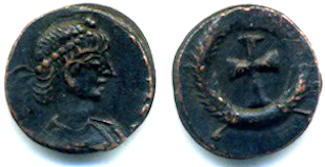 |
Bonifatius. Comes Africae, AD 422-431. ∆ 11mm (1.0 g). Carthage mint. Struck AD 423-425. DOMINORVM NOSTRV, pearl-diademed, draped, and cuirassed bust right / Cross within wreath. RIC X 3817. (Image courtesy ACC) | |
|
Eastern Empire Leo II and Zeno (RIC X 801-808) Zeno (1st reign) (RIC X 901-904) |
Western Empire Priscus Attalus (RIC X 1401-1417) Constantine III (RIC X 1501-1546) Maximus of Barcelona (RIC X 1601-1604) Jovinus and Sebastianus (RIC X 1701-1722) Theodosius II (RIC X 1801-1811) Valentinian III (RIC X 2001-2187) |
Western Empire (con't) Julius Nepos (RIC X 3201-3254) Romulus Augustus (RIC X 3401-3422)
Non-Imperial issues Spanish (Suevi?) (RIC X 3786-3788) African (RIC X 3801-3819) |